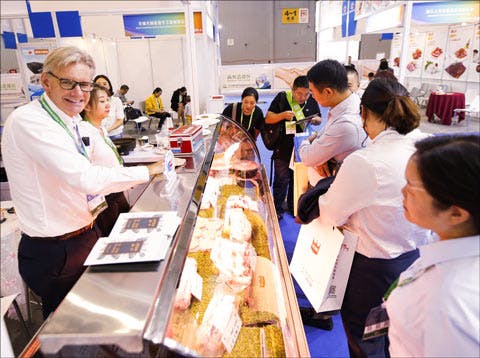U.S. Beef, Pork Industries Look to Capitalize on Expanded Access to China
The USDA Food Safety and Inspection Service (FSIS) has updated its Export Library for China to reflect expanded access for U.S. beef and pork. These changes were among the provisions negotiated in the U.S.-China Phase One Economic and Trade Agreement that was signed Jan. 15 and entered into force Feb. 14. USTR and USDA provided a progress report on implementation of the agreement in this joint press release.
"This is an exciting day for the U.S. beef and pork industries, which have waited a long time to have more meaningful and reliable access to China," said USMEF President and CEO Dan Halstrom. "USMEF thanks USTR and USDA for their tireless efforts to negotiate and implement this agreement. With much broader access for U.S. beef, the U.S. industry is well-positioned to expand its presence in the largest and fastest growing beef market in the world. The U.S. pork industry has also faced significant barriers that have kept exports to China below their full potential, and these changes will benefit everyone in the U.S. supply chain."
With the 30-month cattle age limit eliminated, beef and beef products (including processed products) from cattle of all ages are now eligible for China, provided they are from facilities listed in the Export Library. China no longer enforces a zero-tolerance policy for growth hormones used in beef production, having adopted the maximum residue limits recognized by the Codex Alimentarius Commission. (China still enforces a zero-tolerance for ractopamine residues.)
Beef and pork trimmings are also now eligible for China but must be labeled as “pieces.”
China is now open to pork and pork products that are slaughtered, further processed, and certified in facilities listed as eligible in the Export Library. Although the U.S. has exported large volumes of pork to China in recent months, having more approved facilities and clear eligibility for processed pork products and trimmings should fuel further export growth.
While U.S. beef and pork are still subject to retaliatory duties in China, this situation has also improved. In early March, China began allowing importers to apply for exclusions from duties imposed in response to U.S. Section 301 tariffs. When successful, this process can lower the effective tariff rate on U.S. beef from 42% to 12%. For U.S. pork, the effective rate for frozen muscle cuts can be lowered from 63% to 33% and the rate for chilled cuts can be lowered from 75% to 45%. For frozen pork offals, the rate can drop from 67% to 37%.

Food industry professionals attending the 2019 China International Meat Industry Exhibition sample U.S. pork and beef products at the USMEF booth
"Although approved on an application-only basis, these duty exclusions are available for a full year," explained Joel Haggard, USMEF senior vice president for the Asia Pacific. "We learned of shipments being cleared at reduced duty rates just one day after applications could be submitted. So that is very positive news and another tailwind for the U.S. industry."
Haggard said the USMEF-China staff has been preparing for expanded access to the market since the Phase One agreement was unveiled earlier this year. Interest from prospective customers has heightened – especially for U.S. beef, which previously had very limited access to China.
"Our team is very engaged with importers and distributors, explaining the new import conditions and assisting them with technical issues such as labeling and product translations," Haggard said. "As the COVID-19 situation continues to improve in China, we also look forward to scaling up our promotional efforts, showcasing the positive attributes of U.S. beef in restaurants, supermarkets and in the increasingly important e-commerce channels. New e-commerce promotions for U.S. beef and pork are set to begin in mid-April."
